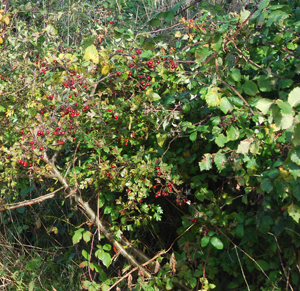How to Lay a Hedge

Hedges are an important part of our countryside, yet they are functional too. The use of hedges goes back hundreds of years (perhaps more) and is an effective way to keep in livestock and mark boundaries. They also have very important benefits for wildlife as they are home to many nesting birds, small mammals and many insects. Apart from being a habitat they also provide a corridor for the movement of animals across field systems and between woodland areas. Landowners need to maintain them but sometimes they get out of control (the hedges rather than the land owners) and once they reach over 4 metres in height they start to encroach upon fields and become “gappy” at the base. It is at this point that they need to be laid - ideally by an experienced hedge layer.
The trees that do well in hedges are hawthorn, blackthorn, field maple, hazel oak, sycamore and ash as well as some other species. Different species will require different techniques but broadly the approach is as described here and illustrated on woodlandstv.co.uk.
We were lucky enough to film Neil Sands demonstrating and John Wilson explaining as they laid a badly overgrown hedge at the Weald Woodfair in East Sussex. John has been a member of the South of England Hedge Laying Society for 25 years, since its founding.The Society has about 150 members and organises regular training sessions, competitions and demonstrations.
In the film, they explain that this is not a summer activity: not only do the leaves become more of a problem but there is a risk to nesting birds.Like oysters, the right months for hedge laying have an “r” in the month (September to April, though usually finishing by March).
The process starts with removing the surplus material – twigs, old leaves, debris, brambles, rusty wire. The stem to be laid needs to be selected and about a foot (30cm) off the ground it should be cut almost right through so that it can be bent over and laid at about 45 degrees. Higher up, nearer the top of the hedge, the stem is then cut at an angle. This stem is called a “pleacher” and it is these pleachers which will grow back vigorously with vertical shoots making the hedge livestock-proof.In the Midlands hedge laying is called “plashing” and the French call it “plaisse”.
Stakes are driven in vertically at 18 inch intervals in the centre line of the hedge. The binders are woven between the stakes with ends wedged behind the stakes. Both the stakes and binders are usually from hazel. The final height of the hedge is about 4ft and the stakes will be trimmed off to the same height to give an extremely tidy finish.
- Tools needed are: a billhook, a small axe, a small chainsaw (perhaps, and if you are qualified to use it), wire cutters, thick gloves going over the wrists and a sharpening stone. A first aid kit is needed too – even when things go well this can be something of a “blood sport”!
- Materials: you will need stakes for the verticals, which should be sturdy enough to hammer in, about 5 ft 6 ins high and about 2ins in diameter (ie about 1.7metres by 50mm). For the horizontals you need much longer and more flexible poles called “binders” which should be about 10ft long and about 1½ ins in thickness (ie about 3 metres by 40mm).
- If you are the owner of a woodland, you might have an overgrown hedge which needs laying. If you get it done by a contractor it should cost a little under £10 per linear metre including materials. A good hedge layer in the right conditions might lay 20-25 metres in a day.
- It is possible to get a recommendation from one of the organisations connected with hedge laying or, better still, you can try it yourself. There are a lot of hedge laying courses available that can be found by typing “hedge laying course” into a search engine.Interestingly they all seem to happen on Saturdays in the winter with a typical course taking three Saturdays in succession.
- Although hedges are now well protected and you need permission to remove one or even create a gap in one, they haven’t always been officially appreciated. Until the 1970s, the government paid grants for their removal, arguing that larger fields were more efficient and essential to justify the new and larger tractors. Nowadays, however, new hedges are encouraged and grants are available for planting, but of course this increases the need for maintenance – hence, the need for more hedge layers.
Driving (or even cycling) around the countryside you will be surprised how many recently laid hedges there are once you are on the lookout for them. You may also start to spot those in need of attention and the billhook.
What’s your experience with hedges and hedge laying?
Comments are closed for this post.
Discussion
It has been suggested that the best way to sort out a very leggy beech hedge is to have it laid. I am in Godalming Surrey is there anyone out there who can help? It is about 20 meters in length.
I am happy to pitch in and help if needed but have never done anything like this before so could only be considered unskilled labour.
thanks
Adrian
Hedge laying in the Midlands. Please take a look at my website. Thank you.http://www.grahamteecehedgelaying.com/
HI I AM LOOKING FOR SOMEBODY TO LAY A HEDGE FOR ME IN EAST BRENT SOMERSET IS THERE SOMEONE OUT THERE WHO CAN HELP ITS ABOUT 20 OR 30 METRES CHEERS HARRY
I can’t believe it’s almost 20 years since i learnt to lay a hedge (Devon style) and opportunity’s have been few and far between to get my hand in. Next week i’ve been asked to try and sort out the hedge that borders the allotments with a throughfare, we get a problems with kids coming in e.t.c…Trouble with this hedge is, most of what there is is Elder, a hedge layers no no…still, it’ll shoot from the base, and grow fast so if i can get it to bend without just breaking off i’m sure i can make something of a hedge with it..am also going to gather a load of holly berries to throw in under once the ‘hedge’ is done, as they’ll tolerate the shade, break the wind and hopefully, stop the kids getting in…I am excited to get laying!
Best bet is to copy what already grows in established hedges in your area. But avoid willow like the plague, it grows too fast. Same for sycamore. Oak and ash are best as trees. Good rule of thumb is 50% thorn (hawthorn and/or blackthorn) and 50% other stuff (hazel, beech, rowan, field maple etc). Everything apart from conifers *can* be laid, you just need to get a good balance.
I will be planting a new native hedge soon, I would like a mixed hedge, are they any species to be avoided as not suitable for laying?
I’d second that hazel is fine and stakes cut from it are particularly good.
Hazel is fine. With trees that big your problem is that there are probably big gaps between trees and ideally you want something every couple of feet to grow back from ground level. With hazel you can fill these gaps by layering, which means taking the first stem onto the ground, wounding the bottom and pegging it down so that it puts down roots and forms a new plant. Old blackthorn doesn’t lay well as it’s brittle but hawthorn is tougher. You can stuff the brush you cut off under the stems to keep the angle right. Protect every part of you and good luck in the autumn.
Hi Chris, thanks for the response!
Unfortunately the chainsaw packed up for the winter and I only managed to get it working today so it’ll be a while before I can do anything! Another question, is there a maximum height that growth can be before it’s just too much? The hazel, blackthorn and hawthorn is about 20 ft high. This is a row which I do not think has ever been laid so I’ve got my hands full with it.
Sorry also I’ve read that hazel is a rubbish hedge-laying plant. Is there truth to this?
Can a hawthorn hedge be layed above a fence ? I.e.bottom of garden 6 ‘ fence, above trees now exist the remaining stems about 3′ -4’ apart, the canopy starting about 4’above the fence top.
Jan yes. Stephen no.
Is it at all possible to lay a Leylandii
I have cut the main trunks down to approx 4ft and wondered if i could lay the wispy bits along a wire attached to the stumps
Thanks for any help
I have a short run of old thin hawthorn next to a wooden fence (to be removed) No nests in it so can I lay it now even though it’s a bit late?
Down in the wilds of Wales for a few weeks and the hedges are all pretty well blasted by the winds, hard to find a good stretch to work on, so Welsh. Send help.
Jeremy, I think you are not cutting far enough through before you bend the stem over. Try cutting a bit higher and go 3/4 to 7/8 of the way through the stem at a 5 o’clock angle and then it should split downwards. If it splits upwards, just keep cutting through what’s left and use your foot as a lever to get the split to run downwards. Using a chainsaw is a lot easier than using a billhook once you get over 5-6 inches; same principle, less effort, more noise.
Chris, yes, seems I have a double who has posted mischievously on my behalf! With the weather turning milder I’ll be glad to get back to work tomorrow on a stretch of blackthorn.
Hi,
I’m trying to help my parents out by laying their hazel and blackthorn hedge. However, I’ve encountered problems with the wood splitting and running up the branch. What causes this? Also, how thick are the largest growths that you can lay? How wide before it’s too wide? Would I be right in thinking that when it gets to a certain width, an axe/billhook just isn’t going to be sufficient and I need a chainsaw?
Thanks Chris so you are saying the frost is likely to make the trunk you saw through brittle rather than any other reason for not carrying out the laying during the frosty time.I agree with you that Sean probably got the wrong forum…
Sean – We’re all very happy for you but I think you may have got the wrong forum ;-)
James – Frosty is OK, but not if it’s well below zero at night or staying below zero in the day, because then young trees will tend to snap rather than bend. And maybe your fingers too.
Can a thorn hedge be sucessfully laid if the weather is frosty………….
If not, why – because in theory the hedge is dormant during the winter months?
Thanks
James
It’s done! Got my first lay of the year yesterday.
Hello, Hedgelayer of 30 years. Working in Staffordshire, Shrops and surrounding area.
Thank you. 07941 234244
What is the best month to lay a beech hedge.

Well, that’s it. About 80 yards of hedge laid with mostly Elm and Elder, took me 6 half days to do and the tops of the Elder branches, the brash, has made for a great anti vandal barrier whilst the hedge gets established…this should stop people asking for barbed wire and fences.
James
16 December, 2015